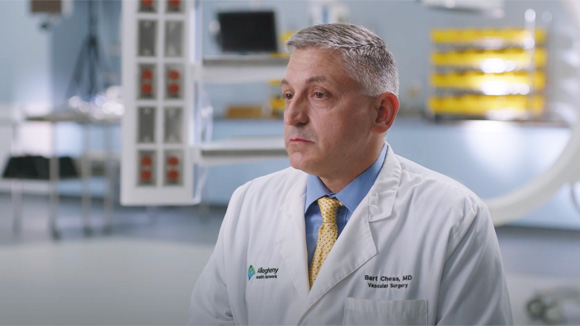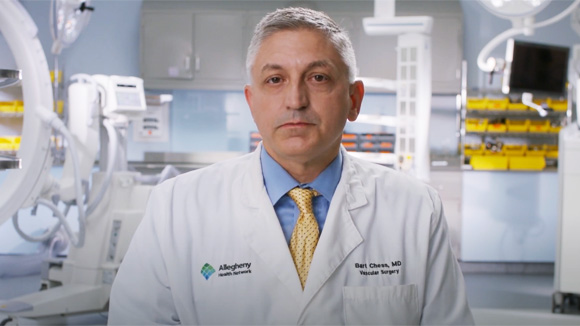Abdominal Aortic Aneurysm
Abdominal aortic aneurysm (AAA) is a ballooning, weakened area in the portion of the aorta that runs through the abdomen. AAA can lead to a tear (dissection) in the artery wall and can cause fatal bleeding. Slow-growing and small abdominal aortic aneurysms may not ever rupture, but fast-growing, large ones may. Those with connective tissue disorders, such as Marfan syndrome, are at risk for aortic aneurysm, heart valve disease, and aortic dissection.
Cardiovascular surgeons at Allegheny Health Network (AHN) Cardiovascular Institute are leaders in using advanced diagnostic technology and therapeutic intervention to diagnose and treat abdominal aortic aneurysms.

"One of the opportunities we have at AHN is access to multidisciplinary teams to help guide our treatment."
Bart Chess, MD — Vascular Surgery
Abdominal aortic aneurysm locations and complications
Aortic aneurysms can develop anywhere along the length of the aorta, a major vessel that runs from the heart through the center of the chest and abdomen. Most aortic aneurysms occur in the abdominal aorta. An abdominal aneurysm located below the kidneys is called an infrarenal aneurysm, whereas a juxtarenal abdominal aortic aneurysm is close to the kidneys.
Most aneurysms are small and asymptomatic. However, a ruptured aneurysm can cause massive internal bleeding and lead to death. If you have an aneurysm, your doctor may recommend a few lifestyle changes and medications to lower your blood pressure and keep the condition from worsening. Patients who are experiencing pain, especially sudden and severe, should seek immediate medical help.
AAA symptoms, causes, and risk factors
Abdominal aortic aneurysms are often difficult to detect because they tend to grow slowly and show no symptoms. Most will remain small and never rupture, though some may grow larger over time — sometimes rapidly.
Signs of an enlarging abdominal aortic aneurysm are:
- Persistent pain in the abdominal area, also referred to as abdominal aortic aneurysm pain.
- Back pain.
- A pulse near the belly button.
If you have a leaking aneurysm or abdominal aortic aneurysm rupture, the following symptoms may appear suddenly:
- Dizziness.
- Nausea and vomiting.
- Rapid heart rate.
- Shortness of breath.
- Intense abdominal or back pain.
- Low blood pressure.
Several factors can cause an abdominal aortic aneurysm, including:
- Atherosclerosis (hardening of the arteries), which occurs when fat and other substances build up inside the blood vessel.
- High blood pressure.
- Blood vessel diseases.
- Infection in the aorta.
- Physical trauma to the body, such as from an auto accident.
Abdominal aortic aneurysm risk factors include:
- Tobacco: Smoking causes the highest risk for developing an abdominal aortic aneurysm.
- Aging: Aneurysms occur most often in people 65 and older.
- Gender: Men are more prone to developing aneurysms than women.
- Race: People who are white are at higher risk.
- Family history: Having family members with a history of aneurysms increases your risk.
- Other aneurysms: Aneurysms in other areas can increase your risk.
Abdominal aortic aneurysms screening and diagnosis
Abdominal aortic aneurysms are often detected during routine physical examinations and diagnosed through imaging tests, such as:
Cardiac magnetic resonance imaging (MRI)
This scan uses radio waves and magnets to create detailed images and videos of your heart’s chambers, valves, and blood vessels in motion. Learn more about cardiovascular imaging.
Computed tomography (CT or CAT) scan
Abdominal aortic aneurysm radiology involves taking a series of X-rays from different angles to provide detailed images of your heart.
Real-time 3D imaging
Imaging that allows physicians to see internal organs and blood vessels from different angles with precise anatomical detail.
Abdominal ultrasound
This is the most common test used to diagnose abdominal aortic aneurysms. It uses sound waves to show how blood is flowing through the abdominal area, including the aorta.
Abdominal aortic aneurysm screening recommendations generally apply to:
- Men and women ages 65 and older who smoke or have smoked in the past.
- Men ages 65 to 75 who have other risk factors, such as a family history of aneurysm.

"Stent graphs can be done under local anesthesia with some sedation, in one of our hybrid rooms which has state-of-the-art imaging."
Bart Chess, MD — Vascular Surgery
Treating abdominal aortic aneurysms at AHN
Treatment for aortic disease is individualized depending on your specific health situation and may involve careful monitoring or surgery. In an effort to prevent an aneurysm from rupturing, abdominal aortic aneurysm surgery options include:
Abdominal endovascular aneurysm repair (EVAR)
This is a common procedure used to repair an abdominal aortic aneurysm. A surgeon will use a catheter to place an endograft or stent graft on the site of the aneurysm. The graft helps strengthen the weakened section of the aorta to prevent the aneurysm from rupturing. This is also referred to as endovascular stent grafting.
Open abdominal surgery
Also referred to as open aneurysm repair, this procedure involves removing the damaged part of the aorta and replacing it with a graft.
The treatment you receive depends on the size of the aortic aneurysm, how fast it's growing, and the shape of your particular aneurysm. Learn more about treating aortic disease.
Recovery and life after abdominal aortic aneurysm surgery
After open abdominal aortic surgery, you can expect the site of the incision to be sore for a few weeks. You will return to see your doctor 10 to 14 days after surgery to have the stitches removed.
You may feel more tired than usual for several weeks after the surgery. Recovery time will depend on each person but should take between two to three months. For six weeks, you should avoid doing any strenuous activity and heavy lifting to prevent problems with the incision on your abdomen.
After endovascular aneurysm repair, you may be sore for seven to 10 days. You can expect to return to normal function in about two weeks. You will need to have an ultrasound or CT scan at least once a year to check on the condition of your repaired aorta.
Make sure to tell your dentist and doctors that you have a graft on your aorta as you may need to take antibiotics before certain procedures to prevent an infection.
Abdominal aortic aneurysm care at AHN: Why choose us?
Our team is known for providing exceptional heart disease care. Here, you benefit from:
Personalized treatment
Our team taps the expertise of doctors from different fields. We develop a treatment plan specific to your health condition and needs. AHN participates in clinical trials for carotid artery stenting and new therapies at the Cardiovascular Research Institute.
Depth of expertise
Cardiovascular surgeons at AHN Cardiovascular Institute and AHN Aortic Disease Program are leaders in performing endovascular aortic aneurysm repair (EVAR) and have years of experience with related procedures such as carotid artery disease, peripheral artery disease, renal artery disease, venous insufficiency and varicose veins, wound healing, lymphedema, and critical limb ischemia.
Contact us
Undiagnosed
If you have not been formally diagnosed yet, call (412) DOCTORS (412) 362-8677 to schedule an appointment with a general cardiologist to be evaluated.
Seeking a second opinion
If you’re already diagnosed with an aortic disease and you are seeking a second opinion, call (412) 359-8820 to schedule a consultation with our Aortic Disease Program.
Connect with the Aortic Disease Program
To schedule a consultation with our Aortic Disease Program, call (412) 359-8820 and connect with our program coordinator.
Scheduling a procedure
If you have a referral to schedule a procedure, contact the team at the facility where you want to have the procedure completed:
Allegheny General Hospital
320 East North Avenue
Pittsburgh, PA 15212
GET DIRECTIONS
Forbes Hospital
2570 Haymaker Road
Monroeville, PA 15146
GET DIRECTIONS
Jefferson Hospital
565 Coal Valley Road
Jefferson Hills, PA 15025
GET DIRECTIONS
Saint Vincent Hospital
232 West 25th Street
Erie, PA 16544
GET DIRECTIONS
-
Appointments
Cardiovascular Institute
By accessing this video, I understand that I am leaving the AHN website and I will be re-directed to an external website operated by a third party platform provider. I acknowledge that the platform provider may collect personal information about me, and about the video that I view, on their platform and may use and disclose this information in accordance with its privacy policy. I agree that Allegheny Health Network is not responsible for the data collection and use practices of this third party.

